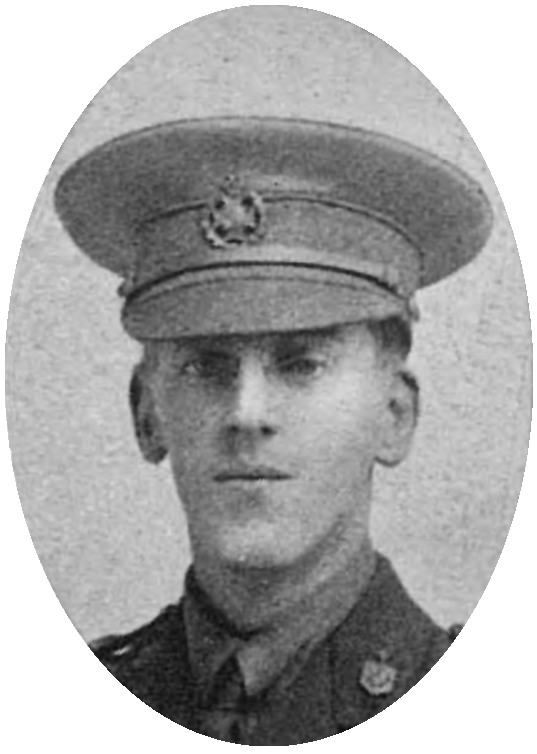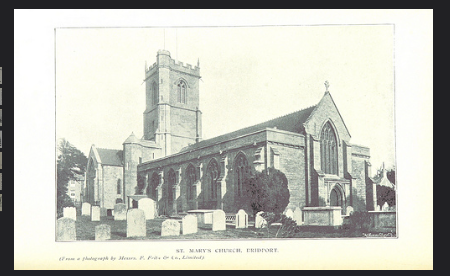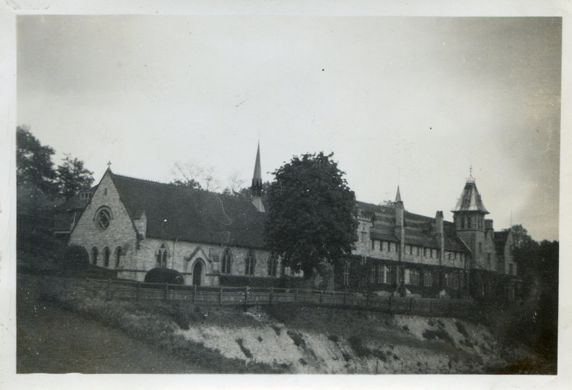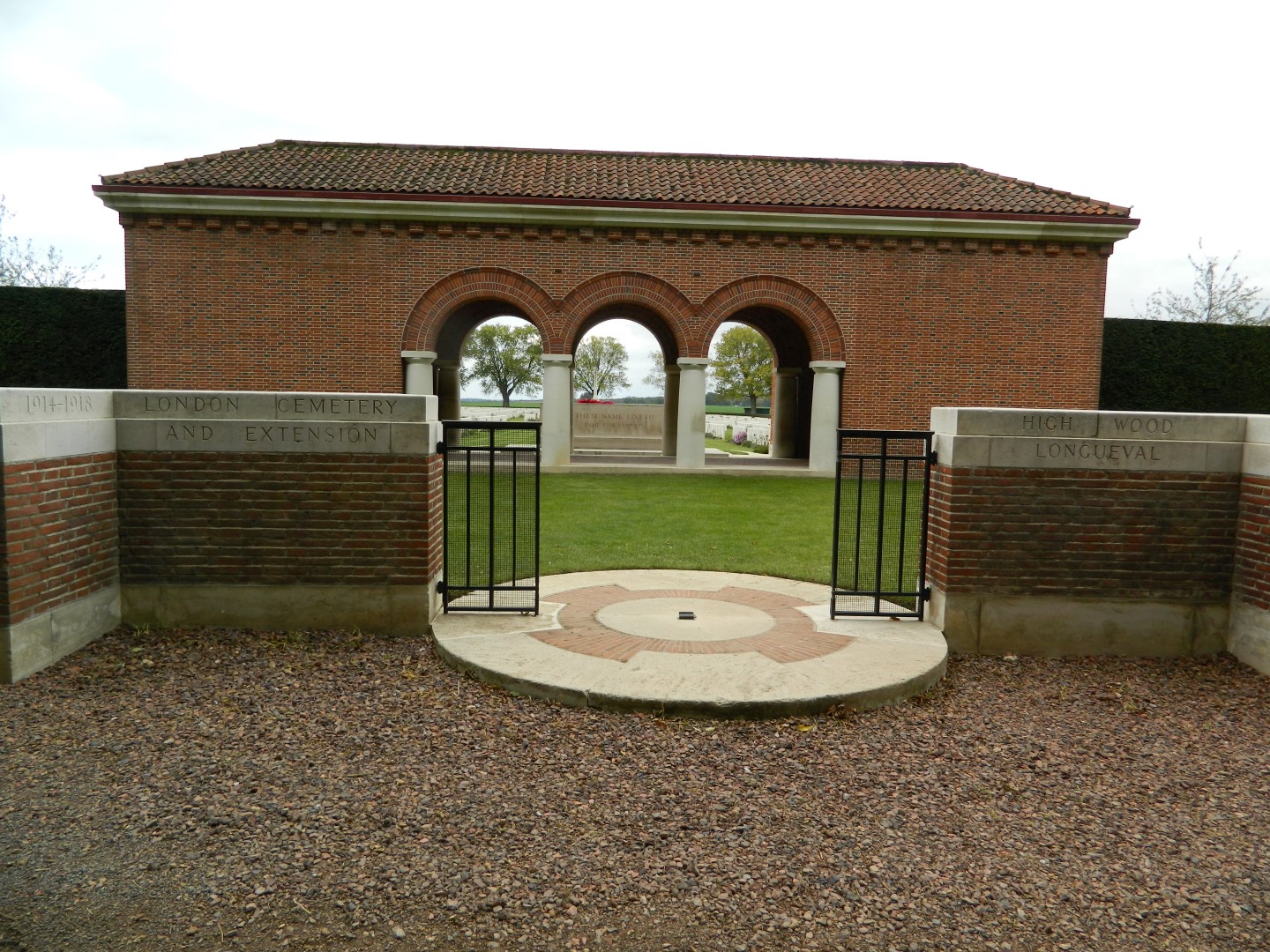Tom Hollingworth Rowson
2nd Lieutenant Tom Hollingworth Rowson, of the London Regiment, 19th (County of London) Battalion (St. Pancras), was killed in action on 15th September 1916, aged 27, and is buried at Longueval, France.
Family Life
Tom was born on the 12th September 1889, to John and Hannah Rowson (née Wicks), in Mansfield, Nottinghamshire. John was from Laceby, Lincolnshire and Hannah from Staines in Middlesex. Tom was the youngest child. Although his mother Hannah had given birth to seven children, only four had survived.
In 1891 the family was living at 110 Bradpole Road in Bridport. John (35) gave his profession as author, journalist, editor and reporter. If John was a published author by this date no evidence of it has been found, however there was a book, published in 1898, entitled Guide to Bridport, West Bay and Neighbourhood’, which is still available to buy, secondhand, on the internet! As well as John and Hannah (35) there were four of their children living with them, Edith Annie (13), Walter (11), Ethel Mary (4), and Tom (1). There had been three other children born to John and Hannah: William Hollingworth (born and died 1881), Elizabeth Olive (born 1882 died 1883), and Olive Amphyllis (born and died 1886). The children had been born in Mansfield, Nottinghamshire. In 1899 we get a glimpse of Tom at school. In the Bridport News of 22nd December there was a report of National School’s Entertainment which states that:
the children were very successful in their performancesThe dialogue, two butcher boys quarrelling and stopped by a policeman, was an amusing bit of acting, the characters being taken by Sidney Crabbe, Tom Rowson and Reg Major, the two former being the butcher boys.
By 1901 the family had moved to 159 South Street, Bridport. Hannah was working as a schoolmistress, her profession before she had started a family, and Tom was the only child still living at home. Tom’s middle name of Hollingworth was in tribute to his paternal grandmother. The two older children’s whereabouts are something of a mystery in 1901, but Edith resurfaces in 1905 when she married Norman Ridley, a farmer. There is a possibility that Walter joined the navy, as he turns up described as a sailor in 1904, on a ship bound for New York. Ethel was living in Nottingham, a pupil at the Midland Institution for the Blind. By 1911 she is living with her sister and brother-in-law in Yatton, Somerset. John and Hannah were still living in Bridport, but had moved to 78, West Bay Road.
After completing his education at the National School, Bridport, Tom stayed at the school as a pupil teacher, and then as an assistant teacher. While he was a pupil teacher, as well as tuition from the headteacher, Tom also attended a pupil teacher centre. He took courses there including one in Elementary Science as well as receiving physical training. Tom took the Preliminary Examination for the Certificate in Spring 1908, gaining distinctions in English Language, English Literature and History. He also achieved a distinction in the Archbishops’ Examination for Admission.
Photograph taken from John Rowson’s book flikr.com
In 1911 Tom was living at 79, Sudbourne Road, Brixton Hill, London, a large house with 11 rooms. The head of the household was Kate Darby (40), a Boarding House Proprietor. She had a visitor, probably her sister and a servant, Jessie Spinks (21) living in the house. As well as Tom, now a schoolmaster, the paying boarders included two bank clerks, Eugen Alfred Kirch (30) from Stuttgart, and Juan Ricardo Miguel Meduex from Valencia and two students studying at King’s College.
Winchester Training College
Beginning life as a Teacher
Tom had decided to follow in his mother’s footsteps and train for a career as a teacher. He enrolled at College in 1908 to begin two years of study. The Wintonian Magazine 1908-1910 tells us that Tom was involved in the Debating Club. On the topic of Should games be compulsory in schools?’ he argued against the motion. His opposition on that occasion was Sidney Seeviour, another of the sixty alumni who died in the Great War.
Winchester Training College photograph courtesy of Alwyn Ladell
In his first year, as a Junior, Tom would have had a period of teaching practice in one of the practising schools used by the College. In March 1908 the magazine carried an article written about this experience:
Some members of the year have started their practical teaching at the Practising School. This is a pleasant time to which the remainder have to look forward. It entails a greater amount of work than ordinary life at College, especially in the preparation of lessons in the evening. Several have already experienced the great strain that is made on the vocal organs, particularly those who rely on a loud voice to preserve discipline in the class. As this part of our work here is of the highest importance, we are pleased to see the energy and interest displayed in it.
In the end of first year exams Tom had an average mark of 67.4%. At the end of his college course Tom was awarded Grade A in Reading and Recitation, Science and Music and Grade B for Teaching and Drawing. He was 14th in the order of merit with an average mark of 69.8%. His first job on leaving College was at St Mary’s School, Newington Butts, an area of south-east London near Elephant and Castle. The school had been established as a Charity School for boys in 1710-11, for 20 boys to be taught reading, writing and arithmetic and to be provided with clothing. A school for girls was added some years later and in 1816 they were merged with the Sunday schools of the parish.
War in Europe
We have not yet discovered when Tom enlisted but he began his war service in the Artists’ Rifles. His London County Council Record of Service stated that he was in France for three months. The London Gazette of the 14th June 1916 reports that
Private Tom Hollingworth Rowson from the Artists’ Rifles officers Training Corps to be 2nd Lieutenant. Dated 9th January 1916
Shortly before Tom’s promotion was gazetted, on the 3rd June 1916, he married Dorothy Clara Wheeler who lived at 11 Knight’s Hill, West Norwood. The following month he was sent to France.
By the time of his death he was in the 1/19th (County of London) battalion (St. Pancras), possibly transferred on promotion but no documentary evidence has been found to support that. The 1/19th were within the 47th (2nd London) Division. The Second London Division was a formation of the Territorial Force, but although named the 2nd they were a front line unit and only titled 2nd because there were two London Divisions. His medal card record gives his entry into a theatre of war as 16/6/16. He was to be in France for the beginning of the Battle of the Somme. The 47th Division was involved in the Battle of Flers-Courcelette in which they captured High Wood. It was in this engagement that Tom Rowson died.
According to the London War memorial website:
On 15th September 1916 the offensive on the Somme was renewed with a full scale attack on the German 3rd line of defences. Four Army Corps were used on a front that stretched from Combles, through the village of Flers and on to Courcelette. The artillery barrage that preceded this attack was more concentrated than that on the 1st July and the attack itself was more successful. The villages of Flers, Martinpuich and Courcelette were captured and the enemy was finally pushed out of High Wood, but the breakthrough was not achieved and the reality was that when the battle ended on 22nd September the frontline had just been moved forward a mile or so. The battle is notable for being the first time that tanks were used.
47th (London) Division attacked on 15th September with 140th and 141st Brigades. 141st Brigade was charged with an attack on High Wood itself and at 6:20 a.m. 17th and 18th London, supported by three tanks made their advance. But the tanks proved largely ineffective. One broke down, another received a direct hit and the third was unable to make progress in the rough terrain of the wood. This meant that the enemy machine guns were not put out of action and they took a heavy toll on the advancing troops of 17th and 18th London, so much so that the attack ground to a halt and the men sought cover or returned to their starting line. This made it all very congested when at 7:00 a.m. 19th and 20th London moved forward in support. All four battalions now found themselves crowded together. The Commanding Officer of 19th London rallied some of the men and led them forward once more, but he and all those who went with him were killed. A fresh approach was needed. Bombers made their way round the flanks and at 11:40 a.m.after a fifteen minute hurricane bombardment by 140th trench Mortar Battery, a second attack succeeded. The Germans surrendered in their hundreds and the British line was extended to the edge of the wood. After two months of hard fighting High Wood was finally in British hands.
19th London sustained nearly 300 casualties that day, including Tom Hollingworth Rowson.
Tom is buried at the London Cemetery in Longueval, France , and is commemorated at County Hall in London and at St. Pancras Parish Church. The original London Cemetery at High Wood was begun when 47 men of the 47th Division were buried in a shell hole on 18th and 21st September 1916. Other burials were added later, mainly of officers and men who died on 15th September 1916.
Tom’s probate record shows that he left £140 3s to his widow Dorothy.
Researcher and Author: Dee Sayers
Sources
Alwyn Ladell photography. (2018). Home page. [online] Available at: https://www.flickr.com/photos/alwyn_ladell/sets/72157665876163520/ [Accessed 2018].
Ancestry (2018). Home page. [online] Available at: www.ancestry.co.uk [Accessed 2018].
British History Online (1955). The Church of St. Mary, Newington. [online] Available at: http://www.british-history.ac.uk/survey-london/vol25/pp91-94#h3-0004 [Accessed 2018].
British Newspaper Archive (2018). Bridport News – Friday 22 December 1899. [online] Available at: https://www.britishnewspaperarchive.co.uk/viewer/bl/0001139/18991222/165/0008 [Accessed 2018].
Commonwealth War Graves Commission, (2018). Home page. [online] Available at www.cwgc.org/ [Accessed 2018].
Gro.gov.uk. (2019). General Register Office. [online] Available at: https://www.gro.gov.uk/gro/content/certificates/Login.asp [Accessed 5 Jun. 2019].
Lidgitt, P. and Naylor, P. Cemetery photographs.
The London WW1 Memorial (2018). WW1 War Memorial London. [online] Available at: londonwarmemorial.co.uk [Accessed 2018].
The Long Long Trail, (2018). Welcome to the long long trail. [online] Available at: http://www.longlongtrail.co.uk/ [Accessed 2018].
Vickers, J. University of Winchester Chapel Memorial Rail image.
www.flikr.com/britishlibrary
| University of Winchester Archive “ Hampshire Record Office | ||
| Reference code | Record | |
| 47M91W/ | P2/4 | The Wintonian 1899-1900 |
| 47M91W/ | P2/5 | The Wintonian 1901-1902 |
| 47M91W/ | P2/6 | The Wintonian 1903-1904 |
| 47M91W/ | P2/7 | The Wintonian 1904-1906 |
| 47M91W/ | P2/8 | The Wintonian 1905-1907 |
| 47M91W/ | P2/10 | The Wintonian 1908-1910 |
| 47M91W/ | P2/11 | The Wintonian 1910-1914 |
| 47M91W/ | P2/12 | The Wintonian 1920-1925 |
| 47M91W/ | D1/2 | The Student Register |
| 47M91W/ | S5//5/10 | Photograph of 5 alumni in Mesopotamia |
| 47M91W/ | Q3/6 | A Khaki Diary |
| 47M91W/ | B1/2 | Reports of Training College 1913-1914 |
| 47M91W/ | Q1/5 | Report and Balance Sheets 1904- 1949 |
| 47M91W/ | R2/5 | History of the Volunteers Company 1910 |
| 47M91W/ | L1/2 | College Rules 1920 |
| Hampshire Record Office archive | ||
| 71M88W/6 | List of Prisoners at Kut | |
| 55M81W/PJ1 | Managers’ Minute Book 1876-1903 | |
| All material referenced as 47M91W/ is the copyright of The University of Winchester. Permission to reproduce photographs and other material for this narrative has been agreed by the University and Hampshire Record Office. | ||







